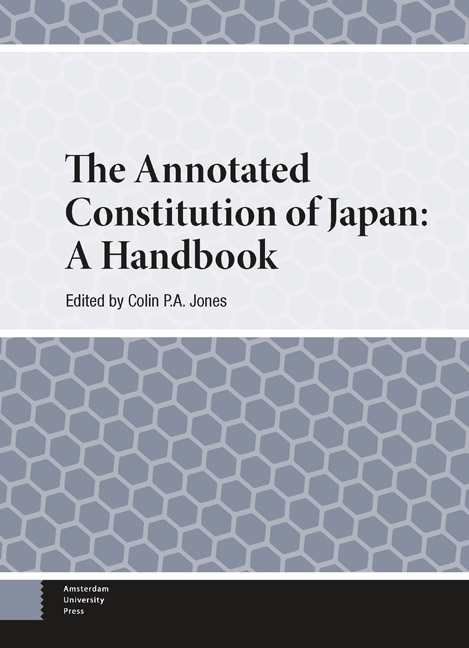Book contents
- Frontmatter
- Dedication
- Contents
- Contributors
- Preface
- Acknowledgements
- Introduction: Historical Overview
- The Preamble
- 1 Chapter I: The Emperor (Articles 1–8)
- 2 Chapter II: Renunciation of War (Article 9)
- 3 Chapter III: Rights and Duties of the People (Articles 10–40)
- 4 Chapter IV: The Diet (Articles 41–64)
- 5 Chapter V: The Cabinet (Articles 65–75)
- 6 Chapter VI: The Judiciary (Articles 76–82)
- 7 Chapter VII: Finance (Articles 83–91)
- 8 Chapter VIII: Local Self Government (Articles 92–95)
- 9 Chapter IX: Amendments (Article 96)
- 10 Chapter X: Supreme Law (Articles 97–99)
- 11 Chapter XI: Supplementary Provisions (Articles 100–103)
- Appendix 1 Constitution of the Empire of Japan (Japanese)
- Appendix 2 Constitution of the Empire of Japan (English translation)
- Appendix 3 The Potsdam Declaration
- Appendix 4 Instrument of Surrender
- Appendix 5 The “MacArthur Notes”
- Appendix 6 The GHQ Draft
- Appendix 7 The Constitution of Japan (Japanese)
- Appendix 8 The Treaty of San Francisco
- Bibliography
- Index
- Index of Articles of the Constitution of Japan
5 - Chapter V: The Cabinet (Articles 65–75)
Published online by Cambridge University Press: 13 February 2024
- Frontmatter
- Dedication
- Contents
- Contributors
- Preface
- Acknowledgements
- Introduction: Historical Overview
- The Preamble
- 1 Chapter I: The Emperor (Articles 1–8)
- 2 Chapter II: Renunciation of War (Article 9)
- 3 Chapter III: Rights and Duties of the People (Articles 10–40)
- 4 Chapter IV: The Diet (Articles 41–64)
- 5 Chapter V: The Cabinet (Articles 65–75)
- 6 Chapter VI: The Judiciary (Articles 76–82)
- 7 Chapter VII: Finance (Articles 83–91)
- 8 Chapter VIII: Local Self Government (Articles 92–95)
- 9 Chapter IX: Amendments (Article 96)
- 10 Chapter X: Supreme Law (Articles 97–99)
- 11 Chapter XI: Supplementary Provisions (Articles 100–103)
- Appendix 1 Constitution of the Empire of Japan (Japanese)
- Appendix 2 Constitution of the Empire of Japan (English translation)
- Appendix 3 The Potsdam Declaration
- Appendix 4 Instrument of Surrender
- Appendix 5 The “MacArthur Notes”
- Appendix 6 The GHQ Draft
- Appendix 7 The Constitution of Japan (Japanese)
- Appendix 8 The Treaty of San Francisco
- Bibliography
- Index
- Index of Articles of the Constitution of Japan
Summary
Overview
Chapter V defines the Cabinet. Read together with Chapter IV (the Diet) and Chapter VI (the Judiciary), it is easy to discern a US-style tripartite “separation of powers” structure in the constitution but even easier to be misled as to the degree of separation. This is further facilitated by the confusing use of the term “executive power” in the English version of Article 65, as discussed at that article.
Insofar as the political party that controls the Diet also controls the Cabinet, the “separation of powers” between the two is less meaningful than in a presidential system of government. In 2016 Prime Minister Shinzō Abe was widely ridiculed for describing himself as the “head of the legislative branch.” But as the leader of the party controlling a majority in both Diet chambers, he might have just been describing political reality, particularly given the dominant role played by the Cabinet in making many of the legislative proposals that become law, as discussed at Articles 59 and 73.
That the constitution contains an entire chapter devoted to the Cabinet is itself a form of refutation of the Meiji constitutional system. Article IV of the Meiji Constitution was comprised of only two articles, one describing the role of ministers of state (Article 55) and the other the Privy Council (Article 56). The word “cabinet” does not appear anywhere in the document.
The first cabinet (naikaku) with a prime minister was established in 1885, several years before the Meiji Constitution was even promulgated. However, the historical experience of those who created that constitution was that a person or institution formally defined as exercising some of the emperor's powers would ultimately usurp more of them, as had happened with the shoguns. Not only were the structures and operations of cabinets under the Meiji system not “constitutional”—in that they were not defined by the constitution, they were not even “legal,” in the sense that they were governed by imperial mandates rather than legislation passed by the Imperial Diet. Lack of constitutional foundations can be seen as a reason why cabinets under the Meiji Constitution were weak, but this might also be seen as a design choice.
- Type
- Chapter
- Information
- The Annotated Constitution of JapanA Handbook, pp. 229 - 247Publisher: Amsterdam University PressPrint publication year: 2023

